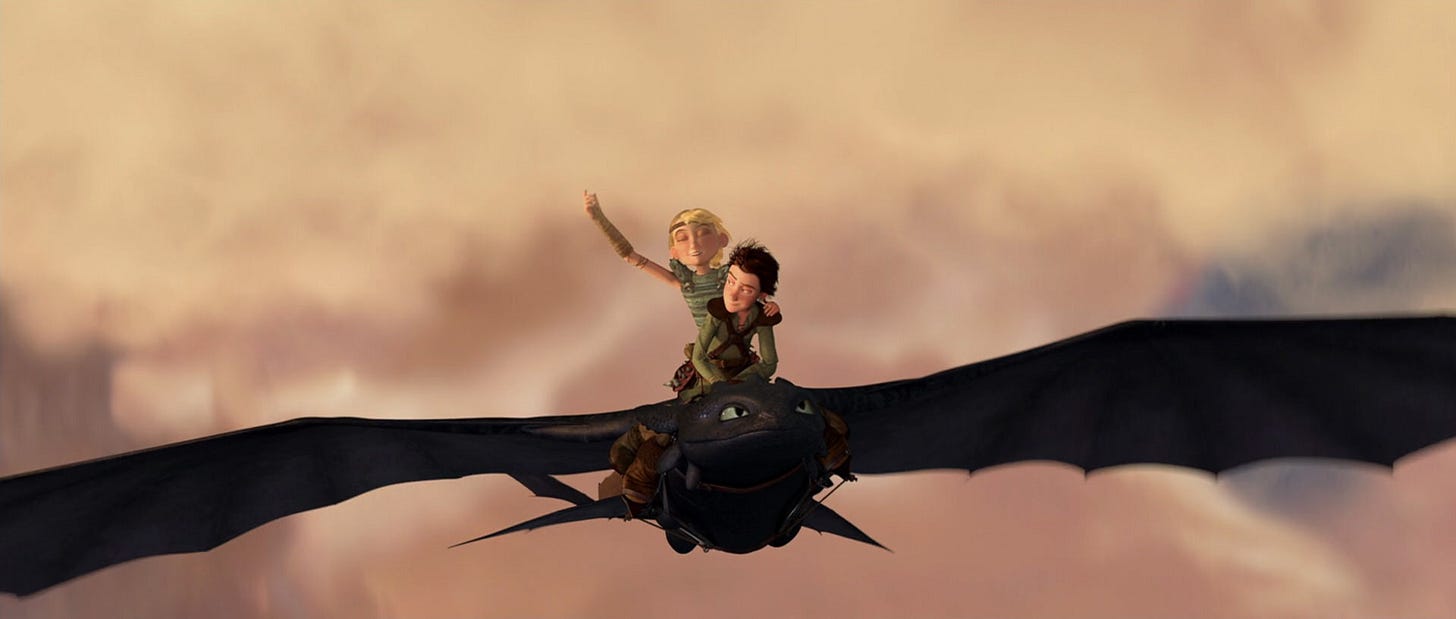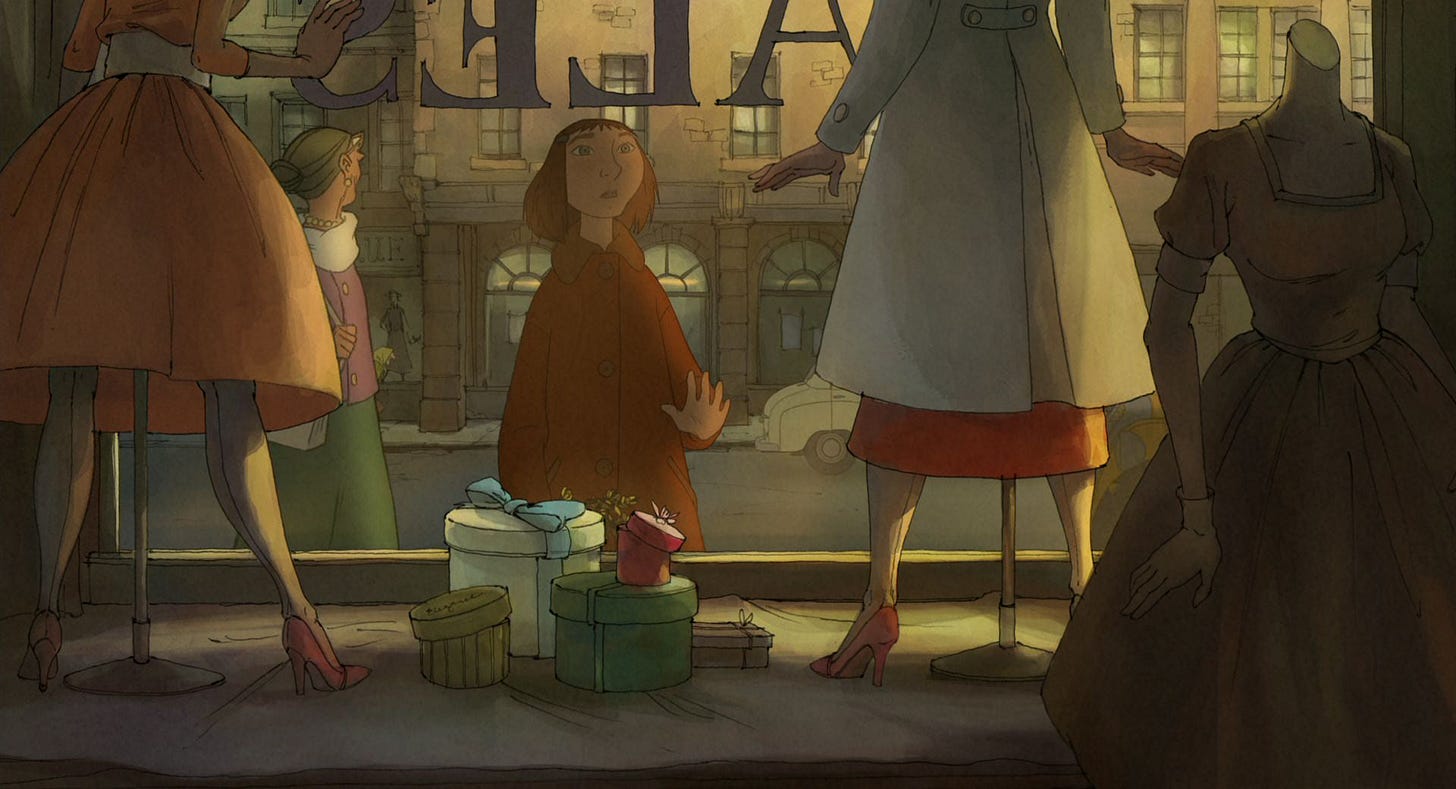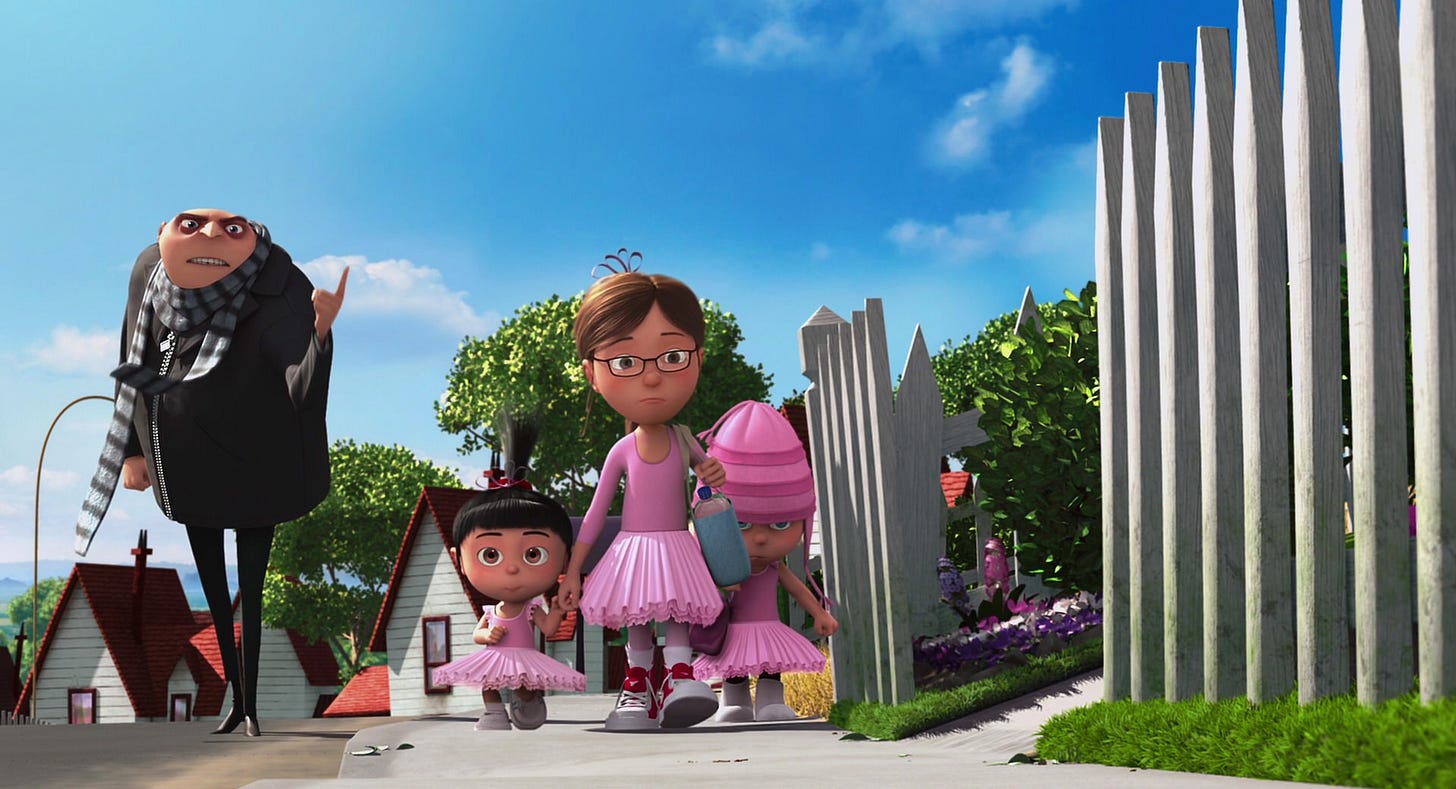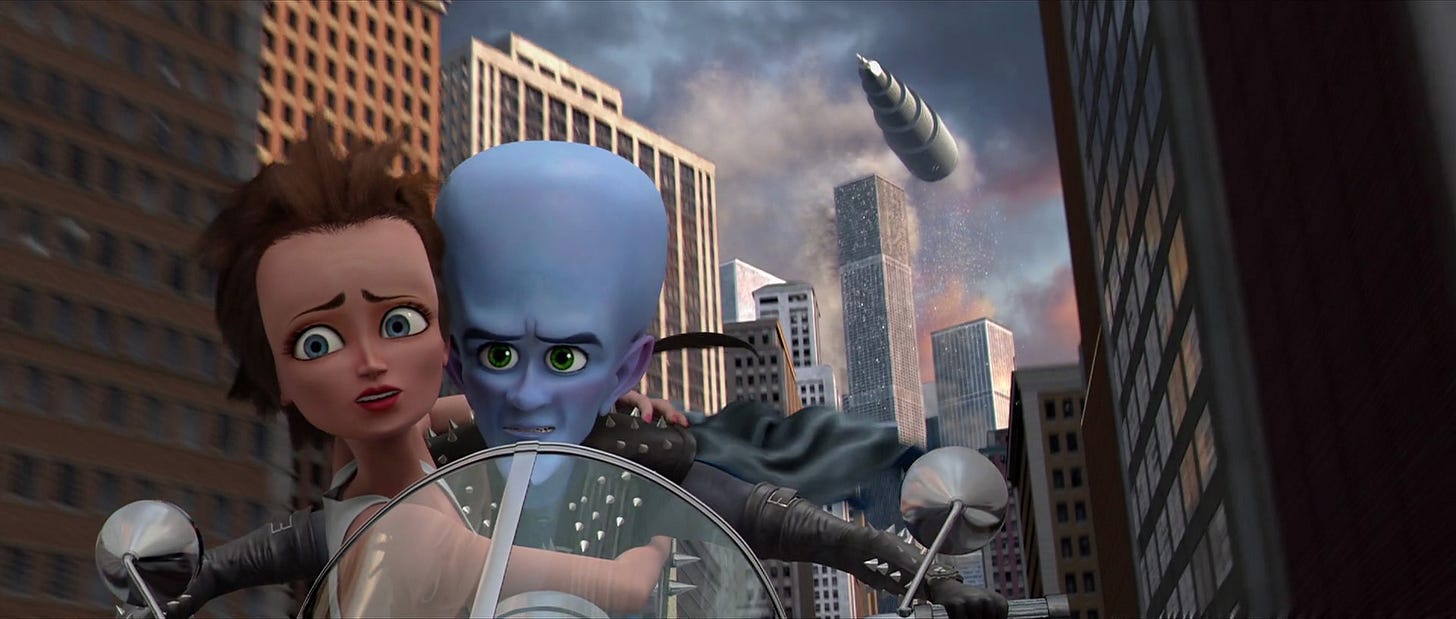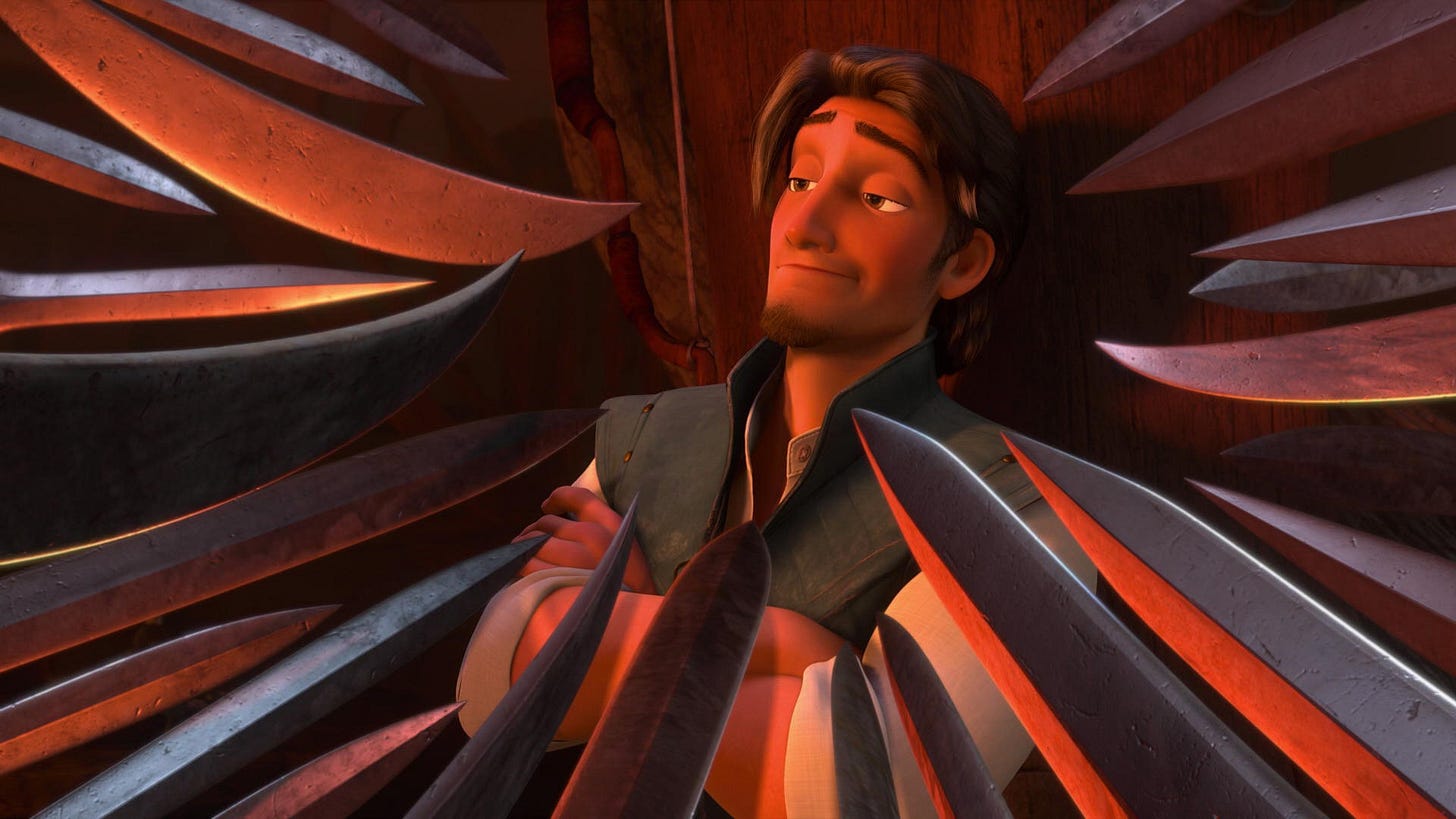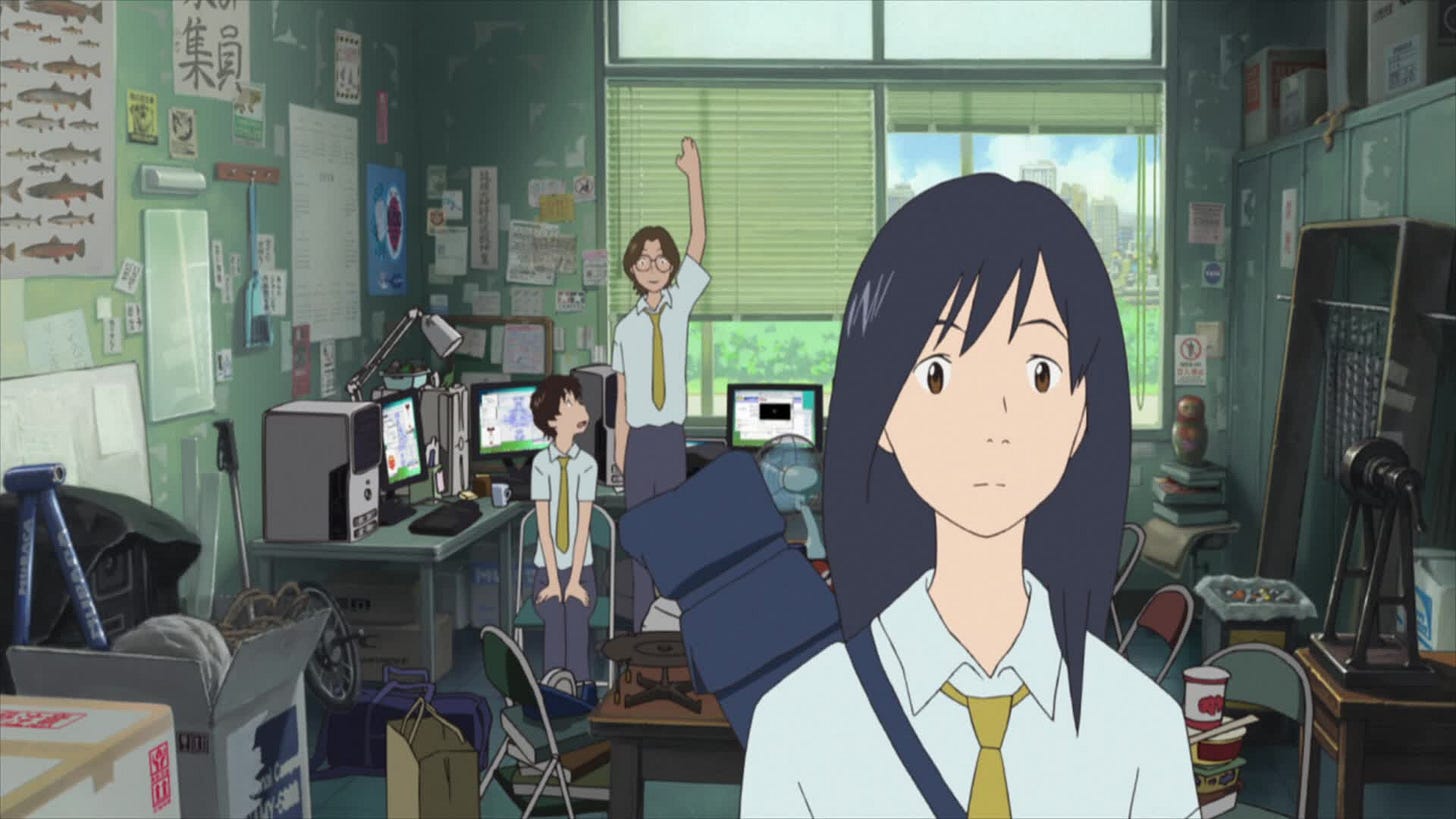Better Animated Feature: 2010
The last year with just three nominees. Can we make the case for more?
This post may be too long for email. We recommend clicking through to the website for the best experience.
Eli: Hello and welcome back! We’ve got seven (7) noteworthy movies to discuss today so let’s cut right to the chase.
The Nominees
Toy Story 3 (won Best Animated Feature)
How to Train Your Dragon (nominated)
The Illusionist (nominated)
Despicable Me (snubbed)
Megamind (snubbed)
Tangled (snubbed)
Summer Wars (snubbed)
The “Best” Animated Feature: Toy Story 3
Eli: In terms of Pixar sequels everyone clamored for, Toy Story 3 wasn’t quite on the level of Incredibles 2, but it was pretty dang close. We’d waited just about as long since Toy Story 2 (11 years) as we would eventually wait between Incredibles movies (14 years), and quite a bit changed between installments.
From a technical standpoint, 3D animation was much better in 2010 than it was in 1999, when most human characters were still stuck in the uncanny valley and even the non-human characters were pretty shaky. In this present age, the character animations could be a lot more fluid, and the set design a lot more nuanced and vibrant.
From a cultural standpoint, if you were in the target audience for the first two Toy Story movies when they released in the mid-late ‘90s, you were at or near college age here in 2010. Pixar, the smart studio they are, resultantly set Toy Story 3 about a decade after the first two movies and themed it around Andy leaving for college. The universe grew up with the audience.
The movie itself needs basically no introduction, especially given the length of this piece. If you want more in-depth thoughts on it, we’ve already covered that in Pixar Pints. In many ways, it’s essentially a rehash of Toy Story 2 for a modern audience (recycling several character tropes and plot threads)—but Toy Story 2 is both one of the best animated movies of all time and one of the best sequels of any kind of all time, so there are certainly worse templates to copy.
And Toy Story 3 did big numbers: not only was the film a massive critical success, but (without adjusting for inflation) it was also the first animated film to gross over $1 billion worldwide. For all intents and purposes, it was the animated movie of 2010, and it consequently won Pixar their fourth consecutive Best Animated Feature award.
This success—objectively the greatest in the studio’s history to date—became extremely influential to Pixar’s creative strategy over pretty much exactly the next decade. Toy Story 3 was the first of 11 feature films Pixar released in the 2010s, and of those 11 (counting Toy Story 3), seven were sequels. Once the 2020s began, the studio released five originals and a spinoff (Lightyear) before going back to the sequel well just last month.
These sequels tended to be cash cows, with two of them—Incredibles 2 and Finding Dory—also grossing over $1 billion worldwide.1 These sequels also tended to be uncharacteristically bad, as all of them except Toy Story 3 are widely considered to be some of the worst, most uninspired stuff Pixar has ever released. Because Toy Story 3 was the first sequel Pixar had put out since Toy Story 2, eight films and 11 years prior, its widespread triumph is generally considered patient zero for this unfortunate trend.
All that said, though, Toy Story 3 itself is still almost universally beloved, and rightly so in my opinion. Did anything else come out this year?
The Other Animated Features
How to Train Your Dragon — Leah
Nominated
How To Train Your Dragon (HTTYD) has a strong argument for being DreamWorks’ best film. Comparatively, Toy Story 3 also has an argument for being Pixar’s best film. How lucky were we to get these two movies in the same year? Of course, that also means that only one could win, even if the other had a good case. And I do believe HTTYD has a strong case to be made.
HTTYD follows Hiccup, a 15-year-old Viking living on the island of Berk. Berk is frequently attacked by dragons, making dragon fighting and slaying an integral part of this Viking society. Hiccup doesn’t fit the mold of what a Viking is “supposed” to be, and this is exacerbated by his father being the chief of Berk. Determined to prove himself, Hiccup invents a weapon that he uses to shoot down a dragon. Surprised to find that it worked, Hiccup also finds himself not killing the dragon, and instead setting it free. The movie follows the conflict between him learning about and bonding with the dragon (whom he names Toothless) and keeping it a secret from everyone in his village.
What unfolds is a touching story about a misfit boy who befriends a dragon and learns to challenge societal norms around dragons (and around himself). It’s a story that I think most people can relate to in one way or another. Most societies hold some kind of belief that’s damaging on both a personal and a societal level. A lot of people do get told at a young age that something is wrong with them for not living up to specific expectations, though of course not being a tough, dragon-slaying Viking takes that idea to the realm of fantasy instead of the more mundane expectations we face in reality.
While this movie has something important to say about reality, it also keeps the narrative engaging with a world of dragons and Vikings, and all the excitement that goes along with that. I also should note that Toothless is one of the cutest animal friends in the history of cinema. As a cat person, I can appreciate the inspiration that the animators took from felines to animate his movements. It’s very easy to root for him and Hiccup as you watch their friendship deepen throughout the movie.
Another great element of this film is the music. All cards on the table, this is my favorite movie soundtrack. The music does a lot of work to set the mood and tone of the movie. Getting to hear the music in surround sound on this most recent watch-through gave me chills. The leitmotif of the film is really powerful and gives the movie a distinct musical identity.
The style of the movie is also distinct. For the Vikings, the movie really leans into more cartoony character designs, and I think it works for the tone the movie is trying to set. Hiccup’s design serves to further differentiate him from the other teens and the Vikings of Berk. The dragon designs are really well done too: Toothless (as one of the rare and feared Night Fury species of dragon) manages to convey both cute and powerful, doing a lot to express the true nature of dragons in the film, and they got really creative with the other dragon designs (especially the dragons that were paired up with the rest of the teens at the end of the movie; great job matching them together visually). Berk and the surrounding area are also well designed, giving us a sense of the bleakness of life on Berk, but also shifting into more realistic natural beauty when the movie calls for it. Overall, I think DreamWorks did a great job making a style to fit this movie.
Now, how does this all stack up against Toy Story 3: the fourth Pixar film in a row to win Best Animated Feature and some of that studio’s best work? Well, both movies have great animation and visuals. We’re in 2010 now, and CGI-animated films have improved leaps and bounds over what we were getting when this award was brand new in 2001. Both DreamWorks and Pixar have high standards for the quality of their animation and art styles. HTTYD is an original movie, creating an art style for itself, while Toy Story 3 is updating the pre-existing art style of the trilogy for a modern audience. They both have the standard of animation quality audiences were used to by 2010, and I think their art styles do the work needed to create a believable world for both movies. Whether you prefer a dragon island or a daycare prison is up to personal taste.
Both stories are able to resonate with wide audiences, which is why both movies are so highly acclaimed. (HTTYD has a 99% on Rotten Tomatoes and TS3 has a 98%.) Personally, I give a slight edge to HTTYD’s story because the internal logic of that world makes more sense to me and I resonate a little bit more with Hiccup’s story than Woody’s. A gripe I’ve had with the Toy Story series is that the relationship between the toys and their owners is one-sided, since the toys need to hide their lives from their owners. It also unintentionally has a materialistic message, that owning things is equivalent to a human relationship. I realize this is nitpicky, and it doesn’t stop me from enjoying the fantasy of the Toy Story movies, but it does give me a bit of pause when I try to think about their themes.
HTTYD doesn’t really have a problem like that. The rules of Berk as a fantasy world are more intuitive, especially when considering the themes of the movie. The dragons don’t have the weird implications the toys do, and the relationship between Hiccup and Toothless easily outclasses the relationship between Woody and Andy. HTTYD also has just a bit more thematic depth. It touches on difficulties in familial relationships, defying societal expectations and beliefs, and coming of age in one cohesive, entertaining narrative. Toy Story 3 also has depth, touching on what it means to grow up, how tragic events can corrupt a worldview, and how to deal with the grief of life changes, so I don’t mean to disparage it. Which one is more significant to you will probably depend on personal preference and experience, but HTTYD means more to me.
Musically, I think both movies have a great soundtrack, but of course I already stated that one of them is my all-time favorite. Toy Story 3 has a great score, but again, your favorite comes down to personal preference, and I prefer HTTYD’s.
This is honestly one of the closest comparisons I’ve made in terms of quality. It makes sense why Toy Story 3 won, and I understand why someone would vote for it over HTTYD. However, I’m not one of those people. For me, HTTYD is an incredibly touching and meaningful film. It’s one of my favorite animated movies of all time. (Find me about a decade ago and I would’ve told you I liked it better than every Pixar movie.) The touching story, the strong relationship between Hiccup and Toothless, the evergreen allegory about going against the norms of society, and the adorable dragons all push this movie over the top.
Verdict: Better Animated Feature
The Illusionist — Preston
Nominated
There’s a lot to talk about with The Illusionist before you get anywhere close to what the movie itself actually is. The original script was written by legendary filmmaker Jacques Tati in 1956, and it’s evidently a semi-autobiographical work. Its main narrative concerns an older man struggling to provide for, and eventually leaving, his surrogate daughter, a story that could’ve been inspired by Tati’s relationship with two of his children. His elder daughter, Helga Marie-Jeanne Schiel, he never acknowledged and abandoned shortly after her birth; his younger daughter, Sophie Tatischeff, is the subject of the dedication added at the end of the film, and the rights to make The Illusionist ultimately passed from her to Sylvain Chomet2 in 2003, two years after her death.
These circumstances have fostered heated debate over whether Tati ever actually intended to produce the screenplay, and whether Chomet’s decisions for the story aligned with his original vision. Who Tati actually had in mind when working on the script in the late 1950s is far from clear, and the question of how fully Chomet succeeds in matching his distinct, eccentric style is even more impossible to say. You’d be forgiven for forgetting about the actual movie itself amid the messy debate surrounding it.
There is no conclusively right answer to “Should The Illusionist exist?” But we’re not here to discuss that, really; the film exists, and there’s nothing interesting about rehashing a decades-old argument over its creation. What’s far more interesting is…well, The Illusionist itself, which is a work of art. I can offer a conclusive opinion on at least one of the questions posed above: yes, this movie perfectly captures what made Tati’s work magnificent. The contemplative shot composition, the gorgeously hand-drawn backgrounds (more stunning than anything in the BAF’s first decade not made by Ghibli), the drab yet delightful character animation…I have no doubt that, had Tati been around for the minor resurgence of traditional 2D films in the 2010s, this is just the sort of movie he would’ve made.
The story itself is as thin as Tati’s tend to be, but that doesn’t make it any less impactful. Again, I think it’s important to divorce the narrative of this film from its real-world circumstances, because if you read it as being based on Helga’s abandonment, the narrative plainly suggests Tati making excuses for his refusal to acknowledge her. We’re seemingly meant to sympathize with the titular character, trying to maintain the illusion that he can provide his adopted daughter with luxuries while overworking and demeaning himself in order to get by. The Illusionist’s ending leaves plenty of room for interpretation, and it undeniably works magnificently in the context of the film—but there are obviously those who would object to the corresponding idea that there’s some grey area in how Tati acted towards Helga, if that’s what the story is based on.
The Illusionist isn’t perfect, but I think it gets overlooked quite a bit for even more reasons than the usual ones afflicting traditionally animated, originally foreign-language films. Beneath all this drama, there’s an incredibly earnest, heartfelt tale about disillusionment, empathy, and humanity that has rarely been told with such eloquence and poignancy. It’s hard not to see the contrast between Toy Story 3, a film that didn’t provide a massively convincing reason to me that it had to exist, and The Illusionist, a film which is strong enough that it’s hard to care whether the decision to make it was justified or not.
Verdict: Better Animated Feature
Despicable Me — Eli
Snubbed
Cards on the table: I have long had a vendetta against Illumination.
I saw 2016’s The Secret Life of Pets in theaters with two of my younger cousins. At the time, I was 18 and they were 10 and 8. They both ate it up, but I thought it was garbage: extremely derivative of several much better movies and not very funny or touching to boot. I left the theater calling it “the kids’ movie that made me realize I’m too old for kids’ movies”.
A few months later, I watched Sing. I was a card-carrying choir kid from fourth grade all the way through undergrad, so I was culturally required to consume most popular media in which singing was central to the plot.3 Most of my choirmates were raving about Sing and all its musical performances, but I hated this movie also. I found it dull and lacking a central theme, and I didn’t understand why the characters were animals.
At this point, I thought animated movies in general were just getting worse. I was kind of a normie and didn’t really understand the distinctions between studios that weren’t Disney/Pixar. Once I connected the dots, I refused to watch any other Illumination products, a refusal that has continued for the past eight years. I haven’t seen the Mario movie, I never watched either of the Dr. Seuss adaptations, and I steered away from anything involving Minions…
…until today! Yes, despite every film in the Felonius Gru canon being a worldwide smash success (with Minions and Despicable Me 3 each grossing over a billion dollars), this was the first time I had seen any of them.4 I didn’t even know what Despicable Me was actually about. I kinda assumed it was just an hour and a half of Gru and the Minions getting up to various despicable shenanigans; I had no idea Gru adopted foster kids5 and I had never heard of the film’s primary antagonist, Vector.
And after watching the origin of the Illumination empire, I can confidently say: it was fine.
It’s far from perfect. A lot of the character motivations made little sense or were not adequately fleshed out—including Vector’s, which is not something you ever want to say about a main villain—leaving me wondering what exactly the stakes were for most of the runtime.
Many of the voice actors did not go far enough to distinguish their characters from their regular speaking voices: Gru is so obviously Steve Carell to the point that it just sounds like Michael Scott doing one of his trademark insensitive accents, Margo is clearly Miranda Cosgrove and sounds like an animated Carly Shay, Vector’s dad is Will Arnett and sounds exactly like Gob Bluth, the list goes on.
But, y’know, it’s funny enough and it’s touching enough. Most people watching this will enjoy it and feel the emotions the movie wants you to feel at the right times; I certainly did.
And that…is exactly the problem. It’s clear as day that this movie was not made with nearly as much effort as most movies from similar studios; peripherally, it pales in comparison to the average DreamWorks movie and all but the worst Pixar movies. But it still printed money, so…why exert any effort in the first place? Why do many work when few work do trick? It all makes sense now. I understand why The Secret Life of Pets and Sing were the way they were: Illumination had no incentive to do otherwise.
I won’t bother comparing Despicable Me to Toy Story 3, a much better and more thoughtful movie from a studio that actually cares. While Despicable Me does have some genuine high points, it rarely rises above being adequate, and its effect on animation as a medium has been unquestionably negative.
Verdict: Not a better animated feature
Megamind — Eli
Snubbed
And here we have yet another example of studios copying each other and releasing movies at nearly the same time that are far too similar for it to be a coincidence. DreamWorks’ Megamind and Illumination’s Despicable Me both star absurdly exaggerated villains, each assisted by their own non-human Minion(s), in a world of otherwise fairly normal people. Some major life event causes each villain to have a complete change of heart and defect to the good side despite external actors continually pulling them back toward evil. In the end, each villain defeats an even more powerful villain and good reigns supreme, the protagonists living happily ever after.
I’m not really here to litigate who copied whom; I don’t care about that. DreamWorks and Illumination are both big-budget studios that have the resources to make something outstanding from this source material regardless of where it originated. I am here to decide which film is better, and the answer is obviously Megamind.
For one, Megamind’s stakes are always glaringly apparent. The setup makes it clear why every major character acts the way they do, which, y’know, is how stories should be told. This alone makes Megamind a more enjoyable watch for adults. Regardless of their age, most fans of superhero media should get something out of this movie’s takes on common tropes, as well as its commentary on what power means to different people.
The aesthetic of Megamind is also just plain better. The set design is sharper, the character designs tell you more about each character just by looking at them, and the animation is more fluid and visually impressive. This is all stuff you should probably expect from an accomplished studio with DreamWorks’ history over a debut film from the new kid on the block. Still, it’s a big point in Megamind’s favor.
So, given I’ve decided Megamind warrants a comparison to Toy Story 3 on artistic merit, the question becomes whether it comes out ahead. And I’ll just come right out and say that no, it doesn’t. Admittedly, for me, Toy Story 3 is a high bar to clear—I have it as the fourth best Pixar movie—but even if I’m being as charitable as I can to Megamind and as uncharitable as I can to Toy Story 3, I still think the latter is the superior film. I usually use the words “movie” and “film” interchangeably, but I intentionally use “film” here because Toy Story 3 displays the art of filmmaking more masterfully than Megamind does or probably ever could.
Consider how each movie begins. In Toy Story 3, we get the cold open in which the toys play out a combination Old West/sci-fi scene as seen through Andy’s imagination, which transitions into a montage of Andy loving his toys as “You’ve Got a Friend in Me” plays. The song cuts off and leaves a distorted echo at the line “our friendship will never die”, subtly but effectively hinting at the theme of the movie. The whole sequence is iconic—to me, one of the best Pixar has ever produced.
Megamind begins in medias res with a pretty hackneyed “yep, that’s me; you’re probably wondering how I got here” type deal as Megamind falls to his apparent death from hundreds of feet above Metro City. Then it cuts to a minutes-long exposition dump through which Megamind just speeds through his life story in plain English. It works, but there’s nothing artful about it. It needed a rewrite. To be fair to Megamind, it didn’t have the luxury of leaning on an original song its audience already knew and loved. But that isn’t a cheat code or anything—it can be done poorly (see Toy Story 4)—and Megamind could have tried something that didn’t sound like a high schooler reading an autobiographical essay.
But this criticism is small fries in comparison to my biggest beef with Megamind: they let Tina Fey’s character say “gangstas”. And you just can’t do that if you want me to take you 100% seriously.
Verdict: Not a better animated feature
Tangled — Leah
Snubbed
In an alternate universe where Yogi Bear did not get disqualified as a submission for Best Animated Feature (due to not having enough animation), Tangled probably would have gotten a nomination for 2010. But because Yogi Bear did get disqualified, only 15 eligible films were submitted, leaving the list one shy of the required number of submissions for five nominations. For whatever reason, Tangled didn’t make the cut for one of the three nomination slots. To be fair, it still had pretty stiff competition despite the smaller field. But strong competition aside, I think Tangled has enough going for it to be a contender, and looking back, I do think it is one of the most important animated movies to come out in 2010.
Tangled is Disney’s take on the Rapunzel story, a classic Disney Princess retelling of a fairy tale, but this time it’s CGI. It follows our heroine Rapunzel, who is kept in a tower by Mother Gothel under the pretense of safety, but what Mother Gothel really wants is to be the only one with access to Rapunzel’s magic hair, which she uses as a way to keep her youth and stave off the inevitability of old age. Rapunzel is about to turn 18 and really wants to see the floating lanterns that always appear on her birthday (surely that’s not a coincidence).
Tangled marked the start of a new era for Disney, starting off the 2010s with cinematic success and a version of their classic formula updated for 2010s audiences. It’s interesting that it coincided with the release year of what could be called the end of a Pixar era. Next year, Cars 2 would release as Pixar’s first critical flop and first movie to miss an Oscar nomination since the introduction of the award (never mind breaking the four-year winning streak). Toy Story 3 reached a height for Pixar that it would take years for them to reach again (if you’re not arguing for Toy Story 3 as best Pixar movie).
Tangled marks the first CGI Disney princess, taking stylistic elements from the 2D movies that Disney built their success on and translating them to the third dimension. Toy Story 3 did something somewhat comparable by updating the art and animation of the beloved 1990s franchise with 2010 technology. However, because it was the first of its kind, the influence of Tangled’s success on future Disney movies reaches further than Toy Story 3’s influence on future Pixar movies.
If Tangled had been nominated for Best Animated Feature, I could understand why someone would vote for it. It has a great soundtrack, with memorable musical numbers like “Mother Knows Best” and “I See the Light”. The relationship between Mother Gothel and Rapunzel is a great depiction of an abusive parent/child relationship dynamic and it’s narratively satisfying to see Rapunzel overcome the conditioning of her childhood. The love story between Rapunzel and Flynn is also a great relationship to watch develop. Tangled does a good job of making them both sympathetic and making it easy to root for their relationship. And Disney using a new style for their movies and making a serious improvement over their past CGI art styles is a noteworthy achievement.
This is another situation where I think personal taste plays a significant role in preference for Tangled or Toy Story 3. I think how highly someone thinks of Toy Story 3 usually depends on how well they buy into the premise of the Toy Story movies and how necessary they think it was to the trilogy. I tend to think it was a great way to end the trilogy (let’s just live in the past and ignore both the 2019 Best Animated Feature winner and the upcoming 2026 sequel for now), showing the way the toys deal with their grief over not having the same role in Andy’s life and how they move on to make a new kid happy. Other people don’t consider it necessary or too similar to Toy Story 2. Tangled is a great take on a Disney "Princess coming of age and escaping an abusive situation. It’s also a fresh take on the Disney formula itself, influencing their direction in the 2010s. (I honestly wasn’t prepared for the amount of 2010s nostalgia I got from watching this movie.)
It’s ultimately up to you whether or not Tangled’s case is convincing enough. For me, I think the well-crafted story of Toy Story 3 wins out, though I understand why someone would prefer Tangled. It’s a shame there wasn’t enough space to nominate it, but I can’t say I would personally vote to put it over Toy Story 3. Still, it’s an enjoyable movie and has a lot to offer as a cinematic experience, so I can’t blame you if you think it’s the superior film.
Verdict: Not a better animated feature
Summer Wars — Preston
Snubbed
Summer Wars is not a movie that should work at all. There are more concepts, themes, storylines, and characters crammed into these two hours than many directors explore in their entire filmographies—and I’m not saying that strictly as a compliment. There’s a ridiculous amount going on in this story, and it should be a clunky, cluttered, confusing mess of a movie. It almost is.
And yet, somehow, it all comes together. Far from seamlessly, of course, and it’s obvious this could be a better film if it committed to a more narrow, well-rounded plot and cast of characters…but it does still work, and the story’s ambitious scope makes that partial success hit hard. I can’t help but wonder what Mamoru Hosoda could have done if he’d told a story about just one of the trio of main characters, or limited the plot to either low-stakes family drama or high-stakes AI apocalypse—but I also can’t help but be impressed that, in trying to bring all those stories together into one, he actually more or less pulls it off.
I’ll take a step back here to give some context for what Summer Wars is, because while The Illusionist might be obscure, this film is almost a complete unknown in the western hemisphere. I first came across it thanks to its excellent score, composed by Akihiko Matsumoto, which is sadly no longer available on most major music distributors in the United States. The movie itself is even more difficult to pin down, but I think it’s worth doing so. If nothing else, it’s valuable context for Hosoda’s style, which we’ll see again in a few months when we get to 2018 and cover BAF nominee Mirai, his seventh film.
There’s a lot about Summer Wars that fits the stereotypes often associated with non-Ghibli anime movies. You almost get the sense that this is intentional, given how superficial and temporary a lot of it feels; there’s a whole tropey fake-boyfriend plot that kicks the story into motion and foreshadows the actual romance between protagonists Kenji and Natsuki, but it falls apart and is basically forgotten by the end of the first act. The romance plot crops up at a few more overly conspicuous points, and it’s probably the least interesting part of the story…but between extremely hackneyed scenes that make it a bit exhausting to watch, there are also some genuine moments that give a lot of depth to the characters.
(By the way, stick a pin in that idea of an underrated Japanese film with a bumpy romance plotline that isn’t necessarily bad, but distracts from the parts of the movie that develop both characters in more interesting ways. It’s a special tool that’ll help us later.)
The bulk of the actual story concerns two parallel plotlines, either of which could probably stand on its own, but which are layered over each other in a way that defies conventions of genre, pacing, and really just…how much stuff there should be in a movie. One narrative draws out the main setting and most of the cast for the story—a large family reunion to celebrate the 90th birthday of Natsuki’s great-grandmother, no-nonsense matriarch Sakae Jinnouchi. On a practical level, a lot of Summer Wars’ conflict stems from how willing the Jinnouchi family’s many members are to get involved in the second, much higher-stakes narrative: an AI takeover of the futuristic OZ, a virtual setting with high-level accounts that make it possible for the artificial intelligence in question to wreak havoc in the real world.
There are a lot of reasons why Summer Wars works better than it feels like it should. I think there’s something to be said for how much heart the film has—it’s willing to take its time for scenes that need to be heavy and serious, though it always comes back to its colorful, cheerful center in the end. But honestly, a major factor in why this cross-genre story succeeds is how uncomfortably real it feels in the wake of the COVID-19 pandemic. Summer Wars has been noted for its prescience on the straightforward topic of giving too much power to technology since its release, but there’s a lot about what it has to say on apocalypses and societal collapses that hits incredibly hard after 2020. If I’d seen this film five years ago, I don’t know if I would’ve bought that impending disaster would threaten to tear apart families at the seams, that some people would be stubborn enough to simply ignore what was happening all around them and cling to normalcy, that human empathy could matter enough to change the course of a potential apocalypse. I do now.
And, ultimately, I think that’s why I find myself loving Summer Wars so much. It’s not a perfect film—there’s certainly some superficial nonsense and silliness to wade through before you get to the real heart of the story. But it’s got a message of care and compassion that rings true now more than ever, delivered in a way that makes it possible to believe in a world where people do care about each other enough to make real change happen. It’s a film that’ll stick with me forever, and up against a Pixar movie that hasn’t stuck with me longer than a few days on either viewing, the choice is obvious.
Verdict: Better Animated Feature
Running Tally
2001: 2 better (2 nominated; 3 snubbed)
2002: 1 better (4 nominated; 0 snubbed)
2003: 1 better (2 nominated; 2 snubbed)
2004: 0 better (2 nominated; 1 snubbed)
2005: 2 better (2 nominated; 2 snubbed)
2006: 3 better (2 nominated; 2 snubbed)
2007: 3 better (2 nominated; 1 snubbed)
2008: 0 better (2 nominated; 0 snubbed)
2009: 2 better (4 nominated; 2 snubbed)
2010: 3 better (2 nominated; 4 snubbed)
TOTAL: 17 better (24 nominated; 17 snubbed)
Well, Pixar released Cars 2 in 2011, so obviously that didn’t win. In fact, we’re not even going to dignify it with a review. Join us in two weeks as four non-Pixar movies face 2011’s winner, Rango.
Next: 2011 (4 nominated; 0 snubbed)
To say nothing of the newly released Inside Out 2 becoming the highest-grossing film Pixar has ever released
Chomet’s previous film, The Triplets of Belleville, also earned a Best Animated Feature nomination back in 2003, as covered by Leah here.
No lie, the Pitch Perfect cover of Rihanna’s “Don’t Stop the Music” is playing as I type this. (I legitimately think it’s better than the original; the bassline comes out so much better in the a cappella arrangement.)
Unless you count the mere act of existing on Facebook in the mid-’10s and seeing your feed flooded with Minions on a daily basis. Which, of course, I don’t.
Even though the tagline is “Superbad. Superdad.” I hadn’t even seen the poster. That’s how much I avoided Illumination.










